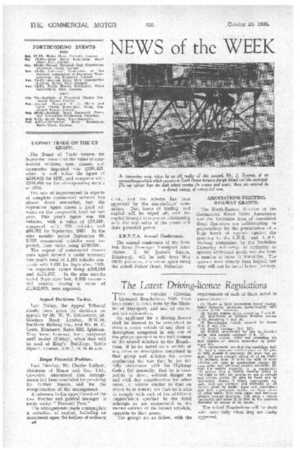The Latest Driving-licence Regulations
Page 38

If you've noticed an error in this article please click here to report it so we can fix it.
E Motor Vehicles (Driving 1 Licences) Regulations, 1936, have been issued in draft form by the Minister of Transport, and are, of course, not yet substantive.
An applicant for a driving licence shall be deemed to be competent to drive a motor vehicle of any class or description comprised in any one of the groups specified in the first column of the second schedule to the Regulations, if he be tested on a vehicle of any class or description comprised in that group and satisfies • the person conducting the test that he is : (a) fully conversant with the Highway Code ; (b) generally, that he is competent to drive, without danger -to and with due consideration for other users, a vehicle similar to that on which he is tested ; (c) that he is able to comply with such of the additional requirements specified in the third schedule as are enumerated in the second column of the second schedule, opposite to that group.
The groups are as follow, with the requirements of each of them noted in parentheses :—
(1) Heavy or light locomotive, motor tractor, heavy motorcar, motorcar, motor-tricycle with, reverse (/-10 inclusive). (2) Trolley vehicle (1-11, excepting 7 and 8).
(3) Motorcycle Or tricycle without reverse (1-10, excepting 7 and 91.
(4) Track-laying vehicle steered by tracks (1-6, 9 and 12). (5) Invalid carriage (1-6, 10). (6) Vehicle constructed for use by disabled driver (not invalid carriage) (1-8, 10). (7) Lawn mower, roller not exceeding 2% tons unladen or vehicle controlled by pedestrian (6).
The requirements are that the candidate shall (1) read a motorcar number-plate at 25 yds.. or with glasses if required; (2) start the engine; (3) move straight ahead or at an angle; (4) overtake, meet or cross the path of other vehicles and take an appropriate course; (5) turn rightand left-hand corners correctly; (6) stop the . vehicle normally or in emergency; (7) reverse into a limited opening either to the right or left; (3) reverse by use of forward and reverse gears; (9) give by hand and by mechanical means, if fitted, appropriate signals: (10) act correctly and promptly on all signals given by traffic signs and controllers, and take appropriate action on those given by other users; (11) turn rightand left-hand corners without de-wiring; (12) drive a vehicle backwards and cause it to face in the opposite direction by means of its tracks.
The actual Regulations will be dealt with more fully when they are finally approved.




























































































